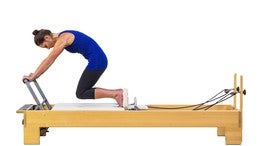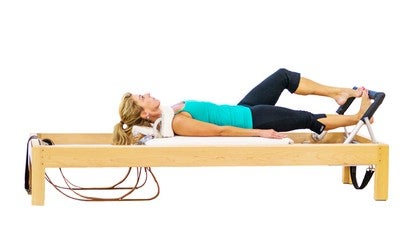Description
Muscle Focus: Legs.
Objective: Aligning the body and strengthening the legs.
Reformer Setup: Start with three to four springs depending on the amount of resistance desired. The footbar is up and the headrest is up.
Start Position: Lie supine on the carriage with the head on the headrest, maintaining a neutral pelvis and spine. Place the balls of both feet onto the footbar, with about an inch of space between the feet, legs parallel, and heels lifted about four inches away from the bar.
Movement: Press the carriage out until both legs are straight. Heels remain lifted in the same position as the start position. Find an external wrap of the thigh muscles while keeping the legs parallel. Lower the right heel underneath the footbar as the left knee bends. Press through both feet to lift both heels, bringing both legs straight. Lower the left heel underneath the footbar as the right knee bends. Press through both feet to bring both legs straight. Repeat nine more times, bend both knees, and bring the carriage back in.
Precautions: Avoid hyperextension of the legs by finding control of the movement from the backs of the legs and the wrap of the thighs. Focus on ensuring that the alignment of the knees and ankles are not compromised by rolling out or in with the ankles and knees, and that the hips are not swinging side to side.
About This Video
Transcript
Read Full Transcript
Okay, Christie, we're going to go over running on the reformer. So this is a complete tutorial, a complete like I've never done running before. What is it good for? What are my goals, what do I want to feel? All of those good things running can be very complicated and we're not gonna really deal with any of those complications because everybody's alignment is different. Some people are bow legged, some people are knock, need some people who are bow legged or bow legged between their hip bones and their knee bones. So in their thigh bounds and some people are bowed legged between their knees and their ankles. So in their shinbones if you will.
So there are different variations, but what the most important thing is is that we are looking to have a nice parallel line and straight alignment in your legs. So we're looking for when the knee is going down, when the feet are moving, that the knees stand straight up and down. And that is really hard for a lot of us. Most people tend to roll in their knees as they put their heels down and running. So that's the most common thing. And so for that reason, when we start off with the beginner and a basic, we won't actually be in parallel. We'll be a little bit in a plotty stance, like just a tiny slightest bed, an inch between the toes, something like that and the heels together.
That helps you work a little more. The outer thighs that have seem to have taken a break in life and aren't easily engaged so that when you're pushing down your heels, your knees are not rolling in. So as we get more advanced as an advanced practitioner, you will want to be parallel and you can either have it parallel with an inch apart or even better, right? Hugging each other, the toes, so the toes would be totally together in parallel. Also the springs have a different levels of intensity. So when we were first starting off, we will want to have four or three springs, maybe three springs as a, as a beginner.
If you're really used to just using your quads for everything, you'll want to keep it on three springs or if you have a bad knee so you're not using that knee joint and taking pressure in it, keep it on three springs. Uh, you could also change it more, but so thinking that you have relatively healthy knees, uh, also the back, um, same thing. So but four springs would be ideal to really feel it in the legs and in the TowerHouse. Now when I say I'm talking four or three springs, I am referring to the equipment I am using, the apparatus I am on, which is a grots apparatus. So it only has four springs there all at the same level. And I know that Jia and some other people have put a good list or table that will try to link up with this tutorial so that you can see whether I should do at half spring or red spring are colored springs that I am fortunately am not aware of how to inform you on that. So, so I have three springs for Christie and I am going to be watching that alignment. So one thing I love to do is teach my clients to start off with um, kind of revisiting the last exercise in the footwork, which is uh, the tendon stretch.
So we're going to have just a small separation between the toes. Good. And so you have weight on the ball of every toe, the ball, the big toe, the next stow and then all of them to even trying to get that pinky on there. That's great. I'm going to be looking for the heels to be together and a slight lift in your arch, which I love what you're doing. So if you would overlap them for me, just really lift up your heels. There you go, that's too high. And if you go down that's too low, I want you to find somewhere in between where you've activated those arches.
Cause then that's going to activate your inner thighs and it's going to activate your pelvic floor and your powerhouse and everything to pull in enough. Okay. I'm also going to be looking at your ankle bones when you run, whether they're going to knock together, whether your ankles are going to collapse. So there's a lot in running. So that's why I like to revisit the tendon stretch. So we're gonna pull your belly always in and up, and let's pull the apparatus out and hold it out with both legs. So from each hip bone, I love to imagine that you have a barbershop pole, red and white stripes swirling all the way down so that those outer thighs have engaged. You have engaged the back of your inner thighs.
The knees are slightly looking away from each other because your toes are slightly apart. In this example, and your ankle bones are not touching. And I want you to push both heels down, taking one two and hold to when you're pushing both down, your ankle bone shouldn't be touching either and they're not good job. Good. And your knee should still be looking a little away from each other. And using those outer thighs and the seat you're going to pull back up scooping and end up. I love to see a little more in and up with the waist so that there's this lower back link. Yeah, this lift lower both heels down, down, down and pulling up. Up, up. So Christie, do you feel your outer thighs right now? Do you feel your seat? Good job. I think also now can you push the ball of every toe there?
Can you feel your arches lifted? Can you feel your inner thighs are lifting? Good. Can you feel your pelvic floor coming towards you and your power? Beautiful. One more time. Stretching down to three and pulling all of that. Great. So your right knee likes to move a little more than your left, like ever so slightly. That would be like really splitting hairs. Okay. Okay.
We're going to do now, right leg is gonna stay straight going down and the left knee is going to bend. Good. When you did that, you did, you pushed out your right hip a little bit and let that knee roll in a bit. So right now pull it round. Great job. And use the back of your leg and your seat to pull that leg all the way, the heel all the way back up to straight legs and switch for me. Good. And pulling all the way up to straight legs. Good and switch.
And I like you to hold it here because I want you to again feel this. Yes. And switch and pulling all the way up. Nice and switch all their way to when pulling all the way up and switch. Nice. Pulling all the up. So we're gonna hold that and we're going to work from here.
Nice and up. Beautiful. And you're not hyperextending in your knees, which is something else we want to really keep an eye on. But you're not pushing into that knee. You're doing a good job all the way up. Good. And now bend the knees and come home. So that was really nice work. Extremely boring though.
So we're going to go into what the tempo really is for running. Okay. Cause that's just like way too broken down and methodical and almost a bad way. So we want to all those feelings, but we do want, it's called running. So we want a good tempo. When we do that, it is easy to turn it into just a quad and down and down and down and you'll feel your apparatus literally slight forward and forward and forward and move. So it shouldn't be moving this way because you should be equally point up.
So even though we're not going to pause every up, I want that body to feel like, Ooh, I'm doing a full circular motion up and running like that. Not just down, down, down. Okay. All right, so we're going to lifting those nice arches, lifting the inner thighs and everything pulls out that nice energy out the crown of your head and go ahead and run and pulling more. That's it. And all the way up using seen, pulling the back of the thighs and the seed to really pulling up with you, pulling up with you, not sticking any hips out. Great job. Good. You're doing a beautiful job. [inaudible] it, love it. And three the knees are looking good and to keep it a little clicker and legs together and come back. Great job. Really Nice.
One other thing that Chrissy did not do and so I didn't have to comment on it cause I love just teaching the body in front of me is as that heel goes down, we often show what our posture is when we stand, which is this. So often you can go ahead and show what that would look like. We stick out hip to the side as we run. And you didn't do that. You stayed solid because kind of we started with that tendon stretch first. So you had that stability of both legs go in down.
So then that allowed you to understand what your stable pelvis should feel like and your powerhouse lifting up in the opposite. You also didn't do much pushing with your shoulders. It was a lift through your powerhouse. It wasn't aligned Bakker up. That's right when you're running and that wouldn't help you either. So that was really lovely. Good, great.
Those that hyperextend you really just have to keep your knee soft. It's hard. I used to hyperextend a lot and I really did, uh, need an instructor to have their hand just underneath my knee each time to remind me to train my muscles to get that awareness. It's hard when you're on your own, but if you do are on your own and you need to do it, you have to keep it just a little soft. The knee doesn't want to be totally bent at an angle, but just go ahead and go straight legs and just a little softer like that. So I don't know if you can show a hyperextension yep, there you go.
But you don't want to be. Now the complete too much would be like that. You don't want to be too bad either, but just a little soft. But it is hard if you're on your own because it's your natural tendency. And so it's something that you don't feel too easily. That's right. Good. All right.
And therefore that is the running on the reformer.
The Pilates Essentials: Reformer Exercise Breakdowns
Comments
You need to be a subscriber to post a comment.
Please Log In or Create an Account to start your free trial.
















